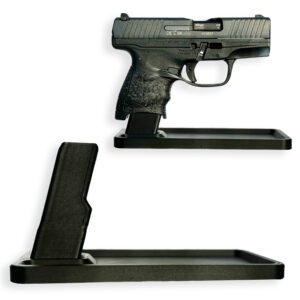
Categories:
The AR15 and M16 are two popular guns that have become synonymous with modern warfare, self-defense, and recreational shooting. While they may appear similar at first glance, there are key differences between these two rifles that set them apart in terms of design, functionality, and intended use. The AR15, or Armalite Rifle 15, is a semi-automatic civilian version of the military-grade M16 rifle.
It was originally developed by Eugene Stoner in the 1950s as a lightweight, versatile gun for civilian use. The AR15 is known for its modular design, allowing users to customize various components such as stocks, handguards, and barrels to suit their preferences. On the other hand, the M16 is a selective-fire rifle that has been adopted by several armed forces worldwide since its introduction during the Vietnam War.
The story of the AR15 and M16 begins in the late 1950s when Eugene Stoner, a talented guns engineer, designed a lightweight rifle for the American military. This rifle, known as the ArmaLite Rifle-15 (AR15), featured a gas-operated system that reduced recoil and allowed for rapid semi-automatic fire. In 1959, ArmaLite sold the rights to produce the AR15 to Colt’s Manufacturing Company.
Colt made some modifications to the original design, resulting in what would become known as the M16. The most significant change was replacing the AR15’s direct impingement system with a gas piston system, which improved reliability in combat conditions. The M16 saw its first official use during the Vietnam War in 1963, where it quickly gained notoriety.
When comparing the AR-15 and the M16, it becomes evident that both guns share several common design elements. Both weapons are built around a gas-operated, rotating bolt system, ensuring reliable semi-automatic or fully automatic firing modes. Furthermore, their overall appearance is strikingly similar, featuring a lightweight and compact design with a collapsible stock. However, despite these similarities, there are notable differences between the two guns.
One of the most significant disparities lies in their intended use. The AR-15 is primarily designed for civilian use as a semi-automatic rifle, while the M16 was specifically developed for military applications with selective fire capabilities. Moreover, another key distinguishing factor is the presence of a three-round burst mode on certain variants of the M16 that allows firing three rounds with one trigger pull.
Additionally, military versions generally possess stronger components to withstand more rigorous conditions compared to their civilian counterparts.
The AR15 and M16 are two guns that share a common origin but have distinct differences in their usage. The AR15 is primarily designed for civilian use, offering a wide range of applications such as hunting, target shooting, and personal defense. Its semi-automatic firing mode allows for quick follow-up shots while maintaining accuracy. Additionally, the AR15 can be customized with various accessories to suit individual preferences.
On the other hand, the M16 is exclusively used by military forces worldwide. It is a select-fire rifle capable of firing in semi-automatic or fully automatic modes. The military employs the M16 for combat situations where higher firepower and sustained rates of fire are necessary. With its longer barrel length, increased muzzle velocity, and superior range capabilities, the M16 provides soldiers with enhanced accuracy over longer distances.
When discussing the differences between an AR-15 and an M16, it is crucial to consider the legal restrictions that surround these guns. In the United States, ownership and use of both rifles are subject to specific regulations. The primary distinction lies in their classification under federal law. The AR-15 is widely available for civilian purchase, categorized as a semi-automatic rifle. It can only fire one round per trigger pull, making it legal for civilian ownership in most states.
On the other hand, the M16 is classified as a selective-fire weapon capable of firing in both semi-automatic and fully automatic modes. Under the National Guns Act (NFA), possession of fully automatic guns like the M16 requires extensive paperwork, background checks, and a special tax stamp from the Bureau of Alcohol, Tobacco, Guns and Explosives (ATF).
When comparing the AR-15 and the M16 rifles, several factors come into play that differentiate their performance. Accuracy is a crucial aspect for any gun, and both rifles exhibit impressive precision. However, the M16 typically boasts better accuracy due to its longer barrel length and improved sighting systems. In terms of range, the M16 surpasses the AR-15 due to its higher muzzle velocity and effective engagement distance.
The M16’s larger caliber ammunition enables it to maintain accuracy at longer distances compared to the AR-15. Regarding firepower, both rifles are semi-automatic by default in civilian versions. However, military variants of the M16 can switch to fully automatic fire mode, providing a higher rate of fire compared to the AR-15. While both guns share many similarities in terms of design and functionality, these performance differences make them suitable for distinct purposes.
In conclusion, the AR15 and M16 may seem similar at first glance due to their shared design origins. However, several key distinctions set them apart. The primary difference lies in their intended use: the AR15 is a civilian semi-automatic rifle, while the M16 is a military select-fire weapon capable of automatic fire. This distinction arises from variations in their internal mechanisms and components.
Additionally, the M16 typically features a longer barrel length and a larger gas system compared to the AR15. These modifications enhance accuracy and reliability required for military operations. Furthermore, the M16 often incorporates features such as a bayonet lug, flash suppressor, and an adjustable stock that are absent or restricted on civilian AR15 models. It is crucial to note that while some components may be interchangeable between these guns, modifying an AR15 to mimic an M16’s capabilities is illegal without proper licensing due to strict regulations governing automatic weapons possession.








Colt
Colt M4 Carbine
Colt LE6920
Colt AR-15 A4
Daniel Defense
DDM4 V7
DDM4 V9
DDM4 V11
DDM4 ISR (Integrally Suppressed Rifle)
Smith & Wesson (S&W)
M&P15 Sport II
M&P15 Tactical
M&P15T
Bravo Company Manufacturing (BCM)
BCM Recce-16
BCM Recce-14
BCM MCMR Series
Aero Precision
M4E1 Series
AC-15
AR15 Pistol (Various Configurations)
Ruger
Ruger AR-556
Ruger SR-556
Ruger AR-556 MPR (Multi-Purpose Rifle)
Springfield Armory
Saint Victor
Saint Edge
Saint AR-15
PSA (Palmetto State Armory)
PSA PA-15
PSA AR-V
PSA Jakl (AR Pistol)
FN America
FN 15 Tactical Carbine
FN 15 Patrol
FN 15 DMR
Wilson Combat
Recon Tactical
Super Sniper
Protector Carbine
SIG Sauer
SIG M400 Tread
SIG M400 Elite
SIG M400 SDI
LWRC International
IC DI (Direct Impingement)
IC SPR
IC A5
Bushmaster Guns
XM-15 QRC
Bushmaster MOE
XM-15 Patrolman
Rock River Arms
LAR-15 Entry Tactical
LAR-15 Predator
LAR-15 Elite Comp
Stag Arms
Stag 15 Tactical
Stag 15L (Left-Handed Models)
Stag 15 Valkyrie
Noveske Rifleworks
Noveske Gen 4 N4
Noveske Space Invader (AR Pistol)
Noveske Recon
Anderson Manufacturing
AM-15 Optic Ready
AM-15 M4 Carbine
AM-15 Precision Rifle
Adams Arms
AA-15 Piston Rifle
P2 AARS (Adams Arms Rifle Series)
Black Rain Ordnance
SPEC15 Series
BRO Predator
Fallout 15
Diamondback Guns
DB15 Series
DB15CCMLB
DB15EB
Del-Ton Inc.
DTI-15
Del-Ton Echo 316H
Sierra 316M
Windham Weaponry
Windham SRC
Windham VEX-SS
Windham RMCS-4 (Caliber Conversion System)
Christensen Arms
CA-15 G2
CA-15 Recon
CA-15 Titanium Edition
Patriot Ordnance Factory (POF-USA)
Renegade Plus
P415 Edge
Revolution DI
LaRue Tactical
PredatAR
OBR (Optimized Battle Rifle)
LaRue Stealth 2.0
Battle Arms Development
Workhorse Patrol Carbine
BAD556-LW (Lightweight)
Authority Elite Rifle
Faxon Guns
Ascent AR-15
FX-19 (AR Pistol)
Streamline Ultralight Series
KE Arms
KE-15 SLT (Super Lightweight Tactical)
KE-15 Scout Carbine
Primary Weapons Systems (PWS)
MK1 MOD 2-M
MK116 PRO
MK107 (Piston AR Pistol)
ZEV Technologies
ZEV Core Elite Rifle
ZEV AR15 Billet Rifles
Franklin Armory
BFSIII AR-C1
Militia Model
F17-L (Chambered in .17 WSM)
Seekins Precision
SP15 DMR
NX15 Skeletonized Rifle
Havak Bravo
Aero Precision (Additional Models)
EPC-9 (Pistol Caliber ARs)
VG6 AR Rifles
Barrett Guns
REC7 DI
REC7 Gen II
CMMG
MK4 RCE
Resolute 300
Banshee (AR Pistol)
DPMS Panther Arms
Panther Oracle
Panther LR-308
H&K (Heckler & Koch)
HK MR556A1
HK416 (Military Variant)
Rock Island Armory (Armscor)
VR-80 Tactical AR (Shotgun AR Platform)
Troy Industries
Troy SPC-A3
Troy PAR (Pump Action AR)
Wilson Tactical
Tactical Recon AR
Protector Series
F1 Guns
FDR-15 Skeletonized Rifle
BDRx-15 Series
Juggernaut Tactical
JT-15
JT-10 Precision Rifle
AeroSurplus
Surplus AR-15 Rifles (Budget Models)
Thunder Tactical
AR-15 Basic Carbine
Tactical Builder Sets
Radical Guns
RF-15
Forged AR-Series
Dark Storm Industries
DS-15 Featureless Rifles
DS-10 Typhoon
DRD Tactical
Paratus
Aptus AR Rifles
Bear Creek Arsenal
BCA-15
AR Complete Upper Builds
Aero Survival Rifles (ASI)
ASR Tactical Series
Tactical Edge
WARFIGHTER Series
AR-15 Lightweight Rifles
Lone Star Armory
TX15 DMR
TX15 Carbine
HERA Arms
HERA H7
HERA AR-15 Lower Builds
IWI (Israeli Weapon Industries)
Zion-15
DRD Tactical
Tactical Modular Rifles
Quick-Takedown Rifles
V Seven Weapons
1776 Rifle
Hyperlite Rifle
Core Rifle Systems
Core15 Tac III
Core15 Patrol Rifle
Armalite (Original AR-15 Creator)
M15 Tactical
M15 A4 Carbine
DEF15 (Defensive Sporting Rifle Series)
PSA (Palmetto State Armory Additional Models)
PSAK-47 Hybrid (AR-AK Style Hybrid)
PSA Dagger (Pistol Caliber Configurations)
Odin Works
OTR-15
Odin Recon Rifle
Maxim Defense
MDX-508 PDX (Compact AR Pistol)
MDX-510 Rifle